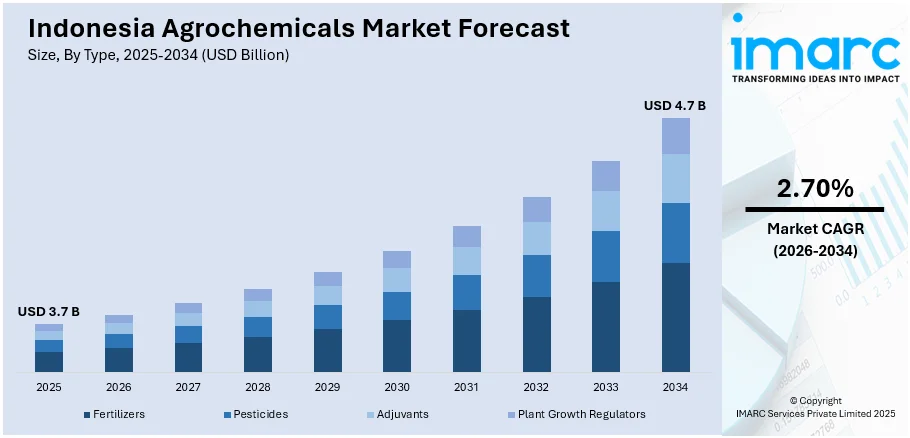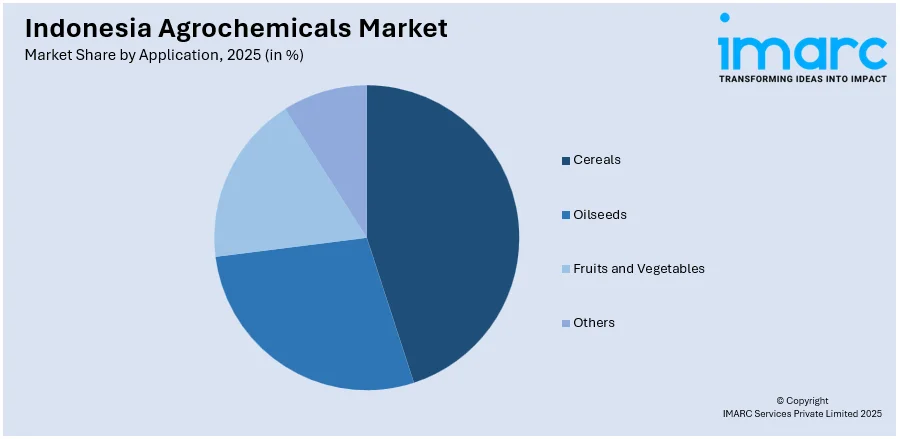
Indonesia Agrochemicals Market Size, Share, Trends and Forecast by Type, Application, and Region, 2026-2034
Market Overview:
Indonesia agrochemicals market size reached USD 3.7 Billion in 2025. Looking forward, IMARC Group expects the market to reach USD 4.7 Billion by 2034, exhibiting a growth rate (CAGR) of 2.70% during 2026-2034. The increasing need for high-quality agricultural products, rising government investment and implementation of favorable policies, integration of precision farming, introduction of various educational initiatives and training programs, and the growing awareness concerning the adverse effects of synthetic agrochemicals represent some of the key factors driving the market.
|
Report Attribute
|
Key Statistics
|
|---|---|
|
Base Year
|
2025
|
|
Forecast Years
|
2026-2034
|
|
Historical Years
|
2020-2025
|
|
Market Size in 2025
|
USD 3.7 Billion |
|
Market Forecast in 2034
|
USD 4.7 Billion |
| Market Growth Rate 2026-2034 | 2.70% |
Agrochemicals refer to substances specifically engineered for use in agriculture to optimize crop yield and protect them against pests. They include fertilizers, pesticides, insecticides, herbicides, and fungicides. Agrochemicals are formulated using phosphorus, potassium, nitrogen, and various organic and inorganic compounds. They possess distinct properties like water solubility, low toxicity to humans and animals, high efficiency rates, and stability against environmental degradation. Agrochemicals are employed in diverse applications such as soil fertility improvement, crop growth regulation, pest management, weed control, disease prevention, and nutrient supply. They offer numerous benefits such as increased agricultural productivity, cost-efficiency, reduced labor force, effective pest control, and prolonged shelf-life of crops. In addition, agrochemicals are known for their ease of application, specificity towards target organisms, quick results, compatibility with modern farming techniques, and potential for sustainable agriculture.

To get more information on this market Request Sample
Indonesia Agrochemicals Market Trends:
The increasing need for high-quality agricultural products for local consumption and exports in Indonesia is one of the major factors stimulating the market growth. In line with this, the escalating utilization of agrochemicals as farmers seek to maximize yield and minimize crop loss is providing a thrust to the market growth. Along with this, the widespread government investment and implementation of favorable policies to modernize agriculture, including the adoption of agrochemicals, is boosting the market growth. Besides this, the integration of precision farming, facilitating the application of agrochemicals in a more targeted and effective manner, is positively impacting the market growth. In addition to this, the rising globalization, leading to increased awareness and access to modern agricultural technologies, is stimulating the market growth. Additionally, the growing adoption of agrochemicals in the country for safeguarding crop health due to the conducive climate that spreads various pests and diseases is providing a thrust to the market growth. Besides this, the increasing trade liberalizations, facilitating the easier import of high-quality agrochemicals, are creating a positive outlook for the market growth. Furthermore, the introduction of various educational initiatives and training programs by the government and private sectors to teach farmers about the correct usage and benefits of agrochemicals is acting as a growth-inducing factor. In line with this, the rising awareness concerning the adverse effects of synthetic agrochemicals on the environment, prompting research and development (R&D) efforts towards bio-based agrochemicals, is favoring the market growth. In addition to this, rapid innovations like the utilization of the Internet of Things (IoT) in agriculture for real-time monitoring of soil and weather conditions are catalyzing the market growth. Apart from this, the development of multi-functional agrochemicals that serve various purposes, resulting in convenience and cost-effectiveness for farmers, is offering lucrative growth opportunities for the market.
Indonesia Agrochemicals Market Segmentation:
IMARC Group provides an analysis of the key trends in each segment of the market, along with forecasts at the country level for 2026-2034. Our report has categorized the market based on type and application.
Type Insights:
- Fertilizers
- Pesticides
- Adjuvants
- Plant Growth Regulators
The report has provided a detailed breakup and analysis of the market based on the type. This includes fertilizers, pesticides, adjuvants, and plant growth regulators.
Application Insights:

Access the comprehensive market breakdown Request Sample
- Cereals
- Oilseeds
- Fruits and Vegetables
- Others
A detailed breakup and analysis of the market based on the application have also been provided in the report. This includes cereals, oilseeds, fruits and vegetables, and others.
Regional Insights:
- Java
- Sumatra
- Kalimantan
- Sulawesi
- Others
The report has also provided a comprehensive analysis of all the major regional markets, which include Java, Sumatra, Kalimantan, Sulawesi, and others.
Competitive Landscape:
The market research report has also provided a comprehensive analysis of the competitive landscape in the market. Competitive analysis such as market structure, key player positioning, top winning strategies, competitive dashboard, and company evaluation quadrant has been covered in the report. Also, detailed profiles of all major companies have been provided.
Indonesia Agrochemicals Market Report Coverage:
| Report Features | Details |
|---|---|
| Base Year of the Analysis | 2025 |
| Historical Period | 2020-2025 |
| Forecast Period | 2026-2034 |
| Units | Billion USD |
| Scope of the Report | Exploration of Historical and Forecast Trends, Industry Catalysts and Challenges, Segment-Wise Historical and Predictive Market Assessment:
|
| Types Covered | Fertilizers, Pesticides, Adjuvants, Plant Growth Regulators |
| Applications Covered | Cereals, Oilseeds, Fruits and Vegetables, Others |
| Regions Covered | Java, Sumatra, Kalimantan, Sulawesi, Others |
| Customization Scope | 10% Free Customization |
| Post-Sale Analyst Support | 10-12 Weeks |
| Delivery Format | PDF and Excel through Email (We can also provide the editable version of the report in PPT/Word format on special request) |
Key Questions Answered in This Report:
- How has the Indonesia agrochemicals market performed so far and how will it perform in the coming years?
- What has been the impact of COVID-19 on the Indonesia agrochemicals market?
- What is the breakup of the Indonesia agrochemicals market on the basis of type?
- What is the breakup of the Indonesia agrochemicals market on the basis of application?
- What are the various stages in the value chain of the Indonesia agrochemicals market?
- What are the key driving factors and challenges in the Indonesia agrochemicals?
- What is the structure of the Indonesia agrochemicals market and who are the key players?
- What is the degree of competition in the Indonesia agrochemicals market?
Key Benefits for Stakeholders:
- IMARC’s industry report offers a comprehensive quantitative analysis of various market segments, historical and current market trends, market forecasts, and dynamics of the Indonesia agrochemicals market from 2020-2034.
- The research report provides the latest information on the market drivers, challenges, and opportunities in the Indonesia agrochemicals market.
- Porter's five forces analysis assist stakeholders in assessing the impact of new entrants, competitive rivalry, supplier power, buyer power, and the threat of substitution. It helps stakeholders to analyze the level of competition within the Indonesia agrochemicals industry and its attractiveness.
- Competitive landscape allows stakeholders to understand their competitive environment and provides an insight into the current positions of key players in the market.
Need more help?
- Speak to our experienced analysts for insights on the current market scenarios.
- Include additional segments and countries to customize the report as per your requirement.
- Gain an unparalleled competitive advantage in your domain by understanding how to utilize the report and positively impacting your operations and revenue.
- For further assistance, please connect with our analysts.
 Request Customization
Request Customization
 Speak to an Analyst
Speak to an Analyst
 Request Brochure
Request Brochure
 Inquire Before Buying
Inquire Before Buying




.webp)




.webp)












